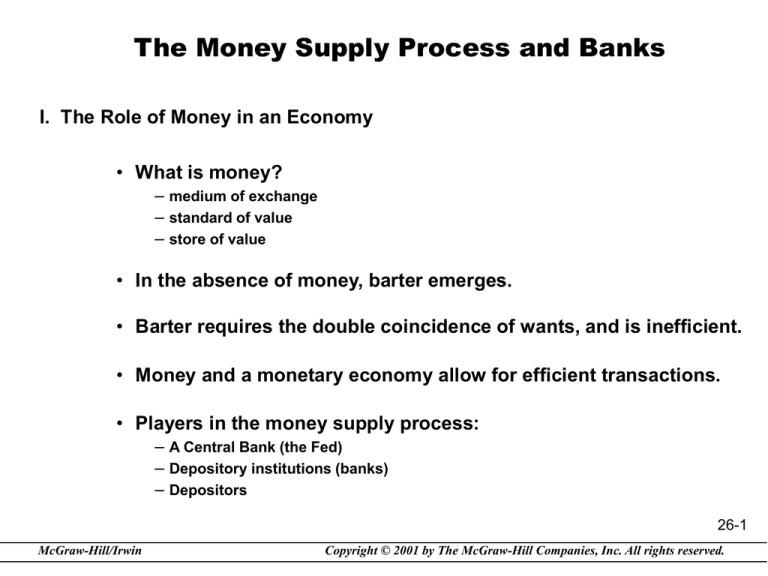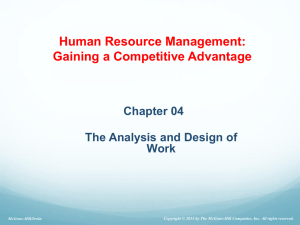
The Money Supply Process and Banks
I. The Role of Money in an Economy
• What is money?
– medium of exchange
– standard of value
– store of value
• In the absence of money, barter emerges.
• Barter requires the double coincidence of wants, and is inefficient.
• Money and a monetary economy allow for efficient transactions.
• Players in the money supply process:
– A Central Bank (the Fed)
– Depository institutions (banks)
– Depositors
26-1
McGraw-Hill/Irwin
Copyright © 2001 by The McGraw-Hill Companies, Inc. All rights reserved.
II. A Simple Model of Banks in the Monetary System
• A bank is an institution that accepts deposits from individuals or
firms and then invests the proceeds in securities or loans.
• A bank needs to hold only a fraction of deposits in reserves.
This is what is meant by the fractional reserve system.
• Funds not held in reserves are available for investment.
Investment in securities or loans expands the total money
supply.
26-2
McGraw-Hill/Irwin
Copyright © 2001 by The McGraw-Hill Companies, Inc. All rights reserved.
A. Multiple Deposit Expansion in the Simple Model
• Assumptions:
1. There is only one bank.
2. Banks hold only required reserves.
3. The public holds no currency.
4. The Fed starts the process by increasing reserves by $100.
• The reserve requirement is the percentage of deposits that is set aside
for regulatory or liquidity purposes.
• Funds beyond the required reserves are excess reserves. They do not
earn any return and are, therefore lent out.
• Excess reserves are calculated:
R e R R r R 0 .10 D
R e
: excess reserves,
R : total reserves,
R r : required reserves,
D : deposits
• The process where one deposit leads to many is multiple deposit
expansion.
26-3
McGraw-Hill/Irwin
Copyright © 2001 by The McGraw-Hill Companies, Inc. All rights reserved.
Insert Balance Sheet 1
B. Multiple Deposit Contraction in the Simple Model
• If the public chooses to increase currency balance sheet items decline
in a process called multiple deposit contraction.
C. Multiple Banks in the Simple Model
• The previous examples can be expanded to a milieu that contains many
banks.
Insert Balance Sheet 2, 3 , 4.& 5
Insert 26.1
26-4
McGraw-Hill/Irwin
Copyright © 2001 by The McGraw-Hill Companies, Inc. All rights reserved.
D. The Deposit Expansion Formula: A Simple Model
• Finding the equilibrium level of deposits requires finding the
reserve multiplier:
D
R :
total reserves,
1
R
r
r : reserve ratio,
D : deposits
• A change in the reserve level will result in a change in deposits
of:
D
:
1
r
R
change in a variable'
s value
26-5
McGraw-Hill/Irwin
Copyright © 2001 by The McGraw-Hill Companies, Inc. All rights reserved.
III. Extending the Simple Model
• The model can be expanded to include other depository
categories.
• Currency (C) plus reserves (R) are referred to as the monetary
base (B) or high powered money:
B=C+R
• Suppose the public holds currency and two types of deposits,
and banks hold excess reserves.
• The two types of deposits are checkable deposits (Dc) and time
deposits (Dt):
D = Dc + Dt
26-6
McGraw-Hill/Irwin
Copyright © 2001 by The McGraw-Hill Companies, Inc. All rights reserved.
• Each deposit has its own required reserve ratio. Therefore
required reserves are:
R r = rc D c + rtD t
• Lastly, add in the excess reserves (Re):
B = rcDc + rtDt + Re + C
• We can use this equation to derive the reserve multiplier for
checking:
Dc
1
rc
B r D
t
t
Re C
26-7
McGraw-Hill/Irwin
Copyright © 2001 by The McGraw-Hill Companies, Inc. All rights reserved.
IV. Money Supply Determination
• Macroeconomists have long debated the relationship between the
quantity of money in an economy and the behavior of the economy.
• Macroeconomists believe that an increase in the money supply will
increase output and result in inflation. It is therefore of importance to
determine the quantity of money.
A. Definition of the Money Supply
• There has long been disagreement as to what instruments should be
included in the definition of money supply.
• We will use the two most common which are used by the Federal
Reserve.
– M1 includes currency, travelers checks, demand deposits, and other
checkable deposits: M1 = Dc + C
– M2 reflects a broader definition of money. It consists of M1 plus small time
deposits, savings deposits, money market accounts, money market mutual
fund balances, and overnight repurchase agreements: M2 = M1 + Dt
26-8
McGraw-Hill/Irwin
Copyright © 2001 by The McGraw-Hill Companies, Inc. All rights reserved.
Insert 26.2, 26.3, & 26.4
B. The Money Multiplier
• How does a change in the monetary base affect money supply? Assume
that currency, time deposits, and excess reserves all grow
proportionately with checkable deposits. Then, every time checkable
deposits change, the other categories will change proportionally. The
proportions are given by:
c
C
Dc
t
Dt
Dc
e
Re
Dc
c: currency relative to checkable deposits
t: time deposits relative to checkable deposits
e: excess reserves relative to checkable deposits
26-9
McGraw-Hill/Irwin
Copyright © 2001 by The McGraw-Hill Companies, Inc. All rights reserved.
Substitution into the formula for the monetary base:
B r c D c r t tD c eD c cD c
Solve for Dc:
Dc
1
rc rt t e c
B
Recall that:
M 1 D c C D c cD c
1 c D
c
Substituting, we get:
M1
1 c
rc rt t e c
B m 1B
26-10
McGraw-Hill/Irwin
Copyright © 2001 by The McGraw-Hill Companies, Inc. All rights reserved.
• Therefore, the M1 money multiplier is:
m1
1 c
rc rt t e c
• Similarly, the M2 money multiplier is:
m2
1 c t
rc rt t e c
• From these money multipliers it can be shown that:
1. an increase in either required reserve ratio will decrease M1 & M2
2. an increase in the currency to checkable deposits ratio will decrease M1 & M2
3. an increase in excess reserves will decrease M1 & M2
4. an increase in the time deposits ratio will decrease M1 but will increase M2
• If the Fed knows the money multiplier, then it knows the effect of a
change in the base on the money supply.
26-11
McGraw-Hill/Irwin
Copyright © 2001 by The McGraw-Hill Companies, Inc. All rights reserved.
IV. Summary
• We explored both the role that money plays in the economy and that
banks play in determining the total money supply.
• We have shown that the money supply is determined by:
– bank behavior
– depositor decisions
– central bank monetary base
• Decisions as to reserve levels and cash holdings have impacts on the
money supply through the multiple deposit creation process; households
change the total money supply by their portfolio decisions.
• The Federal Reserve determines the monetary base which is central to
the determination of the money supply.
26-12
McGraw-Hill/Irwin
Copyright © 2001 by The McGraw-Hill Companies, Inc. All rights reserved.









